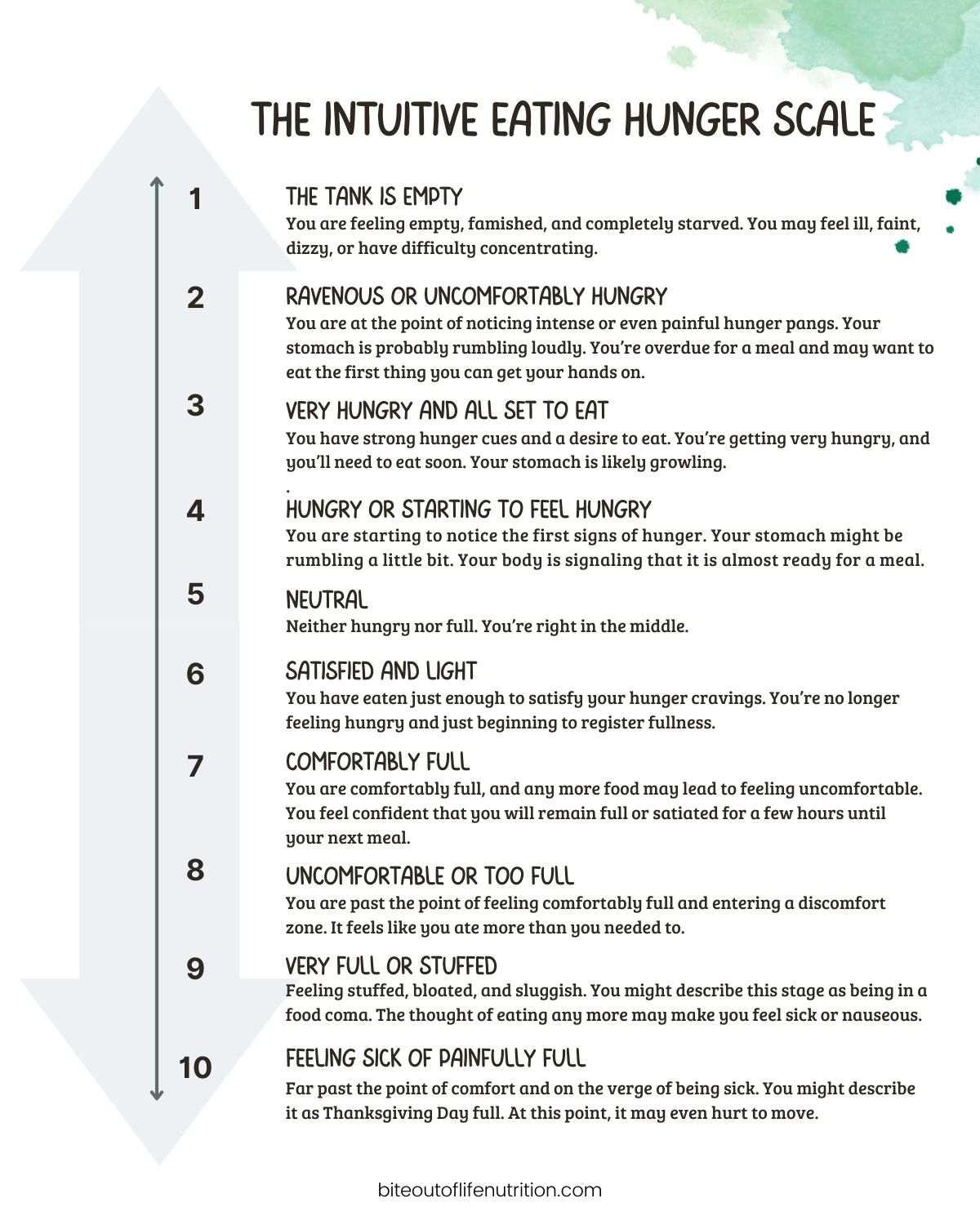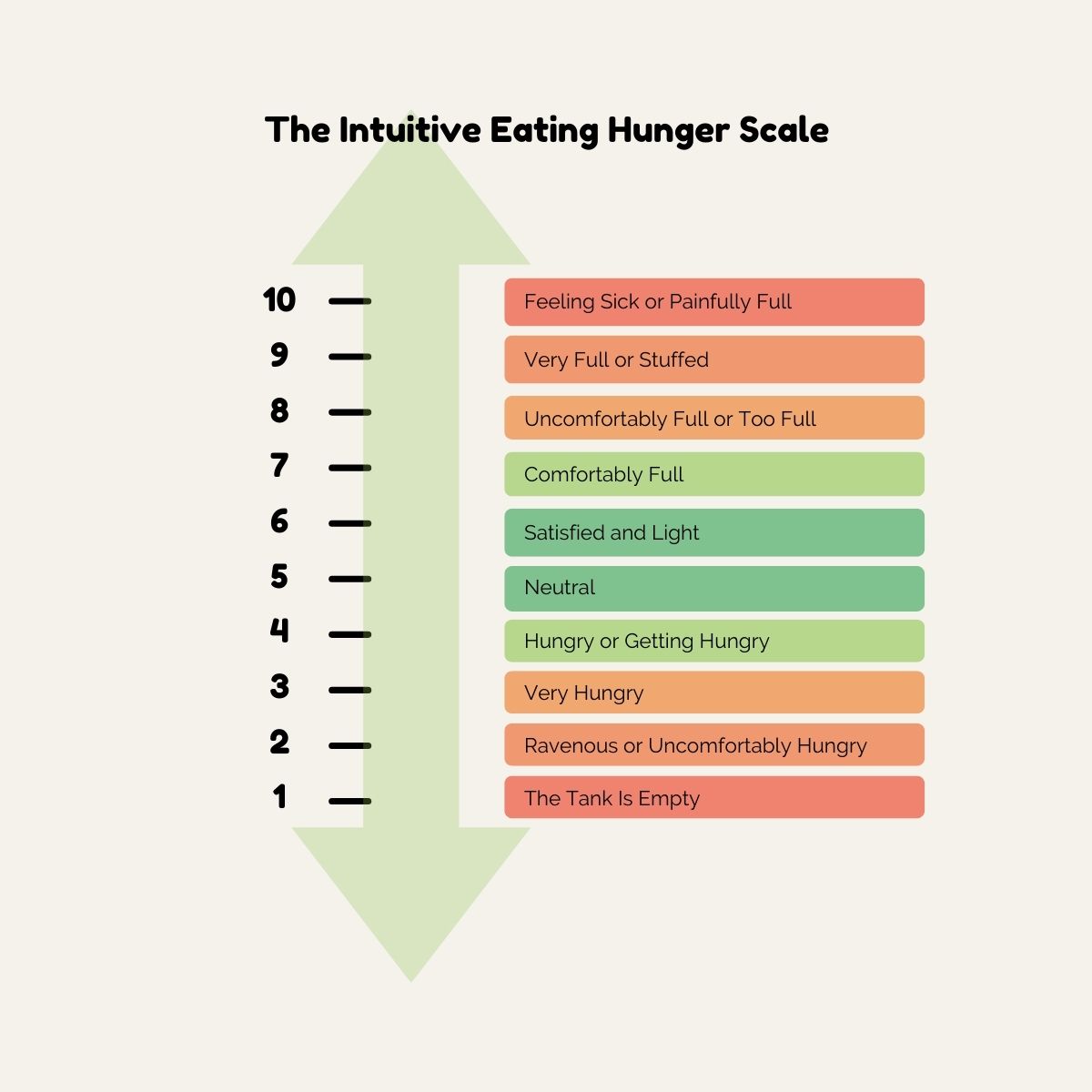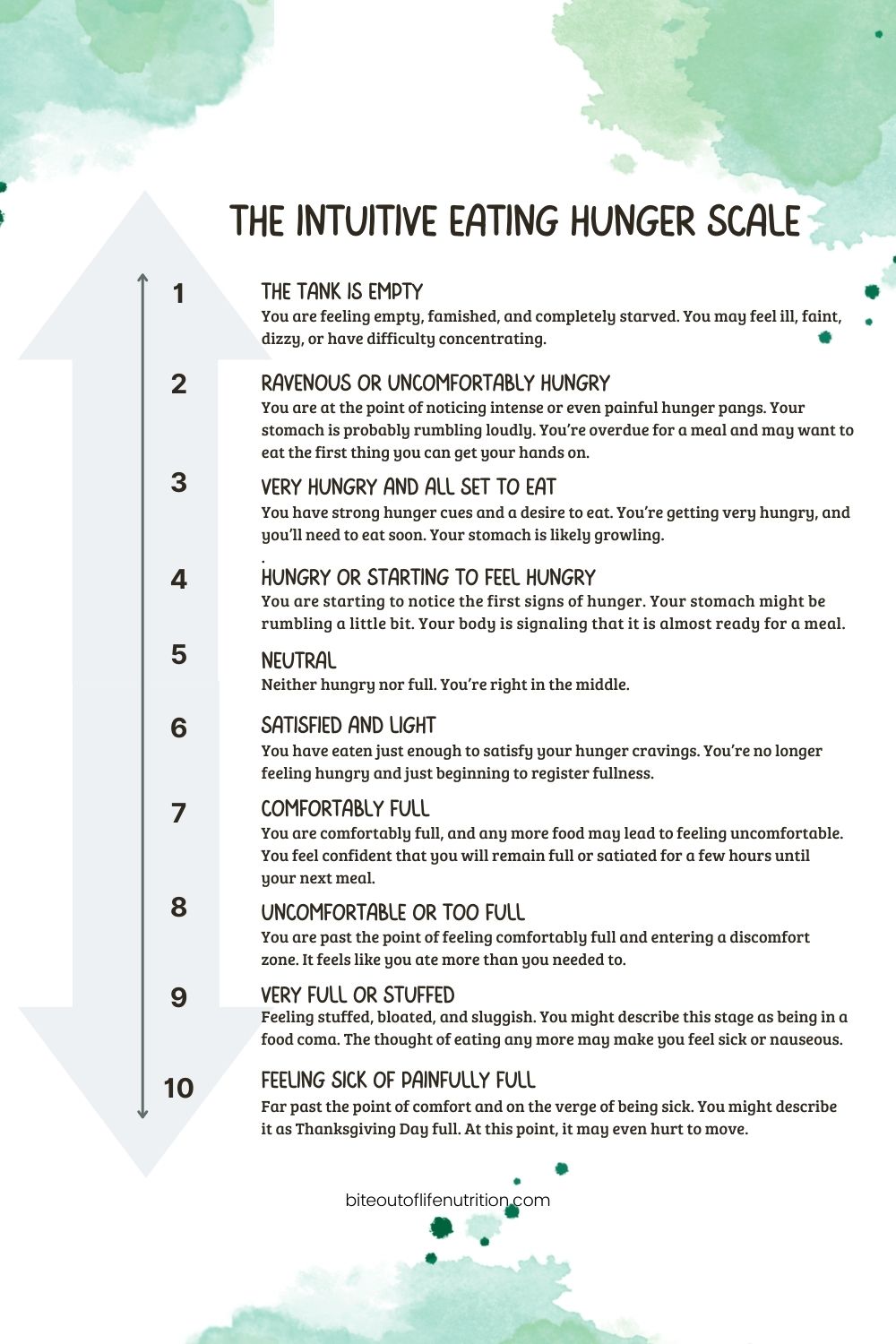Consider the following questions:
- Do you know when you’re hungry?
- What signs or signals tell you that you are hungry?
- Do you usually eat when you are just beginning to feel hungry, or do you wait?
- Do you know when you are comfortably full or satisfied?
- Finally, do you typically stop eating when you are full?
If you answered yes to all of these questions, that’s great! You’re likely already in tune with your body’s hunger and fullness cues and listen to them closely.
However, if you answered no to some of these, you might be out of touch with your internal cues to eat, which is entirely normal. The intuitive eating hunger scale is one tool that can help you tune into your body and reconnect with your hunger and fullness cues again.
Table of Contents
Why Use the Hunger Scale?
As children, we are all experts at eating when we are hungry and noticing when we are full and have eaten enough. Essentially, we are all born intuitive eaters with strong hunger cues.
Over time, many of us lose touch with our hunger and fullness signals. We can become disconnected from our bodies for many reasons, including chronic dieting, emotional eating, stress eating, or simply ignoring our hunger until it becomes too strong.
You might be wondering, why is it important to relearn your hunger and fullness signals? Ultimately, learning to listen to your body and honor your hunger cues can have many benefits, which include:
- Learning to eat portion sizes that fuel the body without leaving us sluggish (no more food comas!)
- Helping you identify the foods that your body wants and needs
- Helping you make smarter food choices (It can be nearly impossible to make healthy food choices when you are ravenous)
- Learning to distinguish between physical hunger and emotional hunger (no more stress eating!)
- Allowing you to eat slower and savor your meals
- Increasing your confidence and trust in your body again
- Improving your mind-body connection
The intuitive eating hunger scale is one tool you can use to relearn these signals.
What Is the Intuitive Eating Hunger Scale?
Eating because you’re actually hungry is a skill you can develop. However, it may take some practice, especially if you’re accustomed to ignoring your internal cues to eat.
Believe it or not, the human body is very good at regulating energy needs, and we all have internal cues that tell us to eat when we’re hungry and stop when we are full. However, many of us spend years overriding these internal signals in favor of dieting, restrictions, and food rules that dictate when we should eat.
For some people, this may result in difficulty identifying the early signs of hunger, meaning they only ever feel “starving.” Some also report never feeling truly satisfied or full after a meal. Additionally, others may find that they are aware of their hunger and satiety cues but have trouble listening to them.
These are all examples of a mind-body disconnect when eating.
The intuitive eating hunger scale is a tool that can help you bring awareness to and honor your hunger and satiety signals.
The intuitive eating hunger scale is a scale from 1 to 10 that allows you to measure your hunger levels, with 1 being ravenous and 10 being completely stuffed. It is also sometimes referred to as the hunger fullness scale, the hunger satiety scale, or the hunger scale.
Overview of the Scale
The intuitive eating hunger scale from 1-10 is as follows:
- The Tank Is Empty- You are feeling empty, famished, and completely starved. You may feel ill, faint, or dizzy.
- Ravenous or Uncomfortably Hungry- You are at the point of noticing intense or even painful hunger pangs. Your stomach feels empty and is probably rumbling loudly. You’re overdue for a meal and may want to eat the first thing you can get your hands on.
- Very Hungry and All Set to Eat- You have strong hunger cues and a desire to eat. You’re getting very hungry, and you’ll need to eat soon. Your stomach is likely growling.
- Hungry or Getting Hungry – You are noticing the first signs of hunger. Your stomach might be rumbling a little bit. Your body is signaling that it is almost ready for a meal.
- Neutral- Neither hungry nor full. You’re right in the middle. Your mind can focus on things other than food.
- Satisfied and Light- You have eaten just enough to satisfy your hunger cravings. You’re no longer feeling hungry and beginning to register fullness.
- Comfortably Full- You are comfortably full, and any more food may lead to feeling uncomfortable. You’ll likely feel confident that you could remain full or satiated for a few hours.
- Uncomfortably Full or Too Full- You are past the point of feeling comfortably full and entering a discomfort zone. It feels like you ate more than you needed to. You may notice that your clothes are feeling tight.
- Very Full or Stuffed- You may feel stuffed, bloated, and sluggish. You might describe this stage as being in a food coma.
- Feeling Sick or Painfully Full- Far past the point of comfort and on the verge of being sick. You might describe this as “Thanksgiving Day full.” At this point, it may even hurt to move.

How to Use the Intuitive Eating Hunger Scale
It’s important to note that the hunger-fullness scale is a general guide rather than a strict set of numbers to follow. For example, a two on the scale could mean different things for different people, and many factors impact how we experience hunger. Ultimately, this scale is a great starting point, but you should do what feels best for your body and appetite.
Still, you might be asking yourself, when should I eat on the hunger scale? As a general rule, you should eat when you are at a 3 or 4 on the hunger scale and stop eating around 6 or 7. In other words, eat when you’re not too hungry and stop when you’re not too full.
For most people, it’s not a good idea to wait until you are at a 1 or 2 to start eating. It may sound counterintuitive, but waiting until you are too hungry usually backfires and may cause you to overeat or eat very quickly in response. This is because the brain views hunger as a threat to survival and has powerful mechanisms in place to ensure you get enough to eat.
When to Use the Hunger Scale
Again, there are no rules about when or how often to use the hunger scale. That said, individuals trying to reestablish their hunger cues may find it helpful to check their hunger throughout the day as well as before a meal. That way, they can begin to recognize the subtle signs of hunger.
As for measuring fullness, consider using the hunger scale at the beginning, middle, and end of a meal. Try asking yourself, “how is my fullness changing throughout this meal?”
Additionally, some people find it helpful to check their fullness an hour to a few hours after eating. For example, checking satiety one to three hours after a meal may help you notice patterns about the foods and meals you find most filling or satisfying.
Identifying Your Intuitive Eating Hunger Cues
Hunger cues are the first indications that you are hungry and will need to eat soon, which seems simple enough. However, many people come to intuitive eating without a clear understanding of what hunger feels like, which is entirely normal. In fact, many people report that they are simply “always hungry.”
Dieting is one of the biggest reasons people disconnect from their hunger-fullness cues. Most diets support eating less than the body needs and then using “willpower” to ignore the subsequent increase in appetite.
This increase in appetite can lead many to believe that they are “always hungry” or “never full,” which causes them to further suppress their hunger signals. Of course, this almost always backfires and often leads us to “break” the diet and overeat in response.
Contrary to popular belief, a rumbling tummy isn’t always the first sign of hunger. In fact, if your stomach is growling loudly, that may be an indication that you’ve waited too long to eat.
The key is learning the sometimes-subtle ways your body tells you it’s hungry (and then honoring that hunger).
Here are some of the different ways that you might experience or feel hunger with intuitive eating:
- Stomach: Empty, dull ache, gnawing, growling or rumbling, hunger pangs (either slight or strong)
- Mind: Cloudy thinking, lightheaded, headache, difficulty concentrating, preoccupation with food, daydreaming about your next meal
- Mood: Hangry, grumpy, irritable, or feeling low
- Mouth: Salivating, especially when thinking about or seeing food
- Energy levels: Low energy, sleepy, sluggish, lethargic
Identifying Fullness With Intuitive Eating
Sometimes it is a little tougher to identify fullness versus hunger. This is because hunger is a strong, primal instinct, whereas fullness is much more subjective.
Finding your “stopping point” will likely take some experimenting and trial-and-error. For example, did you eat to the point that you were uncomfortably full? That’s perfectly okay! Now you know what signs of fullness to look for in the future. Or perhaps you didn’t eat enough at a particular meal and were hungry again an hour later. That’s also fine and is an excellent learning experience.
Additionally, focusing only on fullness when using the hunger-fullness scale might be tempting. Many chronic dieters feel that simply stopping when they are full while ignoring their hunger could be the key to weight loss success. And it’s okay if that is where you are on your intuitive eating journey. For this reason, it is usually best to start by honoring hunger before focusing on satiety signals.
Here are some of the different ways that you might experience or feel “full” with intuitive eating:
- Stomach: Many people report experiencing a sensation of feeling filled, which ranges from a comfortable weight in the stomach to a gentle heaviness.
- Mind: Fewer thoughts about food, diminished desire to eat, clear-headedness, feeling like you can go a few hours without thinking about food
- Mood: Pleasant, relaxed, happy, recharged, content
- Energy levels: Some people report feeling reenergized, while others might feel pleasantly drowsy
Important Reminders
Remember that the intuitive eating hunger scale is more of a guideline than a strict set of rules.
There may be times when you go too long between meals, and that’s okay. Life often gets in the way, and you can be flexible without punishing yourself for mistakes. There may also be times when a food tastes so good that you ignore your fullness to keep eating. This is okay too.
Part of being an intuitive eater is understanding that perfection is unattainable and that your value does not depend on your food choices or body size.
Ultimately, the intuitive eating hunger scale is one of many tools that can help you build a better mind-body connection.
For some, this scale may feel too much like a diet. Unfortunately, diet culture leans into the idea of stopping when you are full while simultaneously advocating diets that leave us very hungry. In a way, it is a very twisted use of the hunger discovery scale, which frequently backfires because we aren’t eating enough on these diets.
If that is the case, perhaps the scale is not a good fit for you at this moment in time. There are plenty of other places where you can start your intuitive eating journey.

The Intuitive Eating Hunger Scale PDF + Activity
The following activity can help you start using the intuitive eating hunger and fullness scale. You’ll need to set aside 25 to 30 minutes for this activity. Additionally, you’ll need to do this exercise during a meal.
Click here for the Intuitive Eating Hunger Scale PDF and printable activity. Or follow along below:
- Begin by taking a few deep breaths before starting the meal. Pause to consider how you are feeling.
- What number is your appetite on the intuitive eating hunger scale? What cues does your body give you to alert you to this hunger? How does seeing the food on the plate in front of you impact your appetite?
- Ideally, you’ll be between 3 or 4 on the hunger scale, where you’re starting to feel hunger pangs but are not ravenous. What does a 3 or 4 on the scale feel like to you?
- Try eating slowly, pausing to savor each bite. It may be helpful to ask yourself a few questions while eating. What do you enjoy about this meal? What are the different flavors and textures? Is this meal as good as you thought it would be?
- Then, halfway through your meal, pause for five minutes to check your hunger. How would you rate your hunger on the scale?
- Continue eating if you’re still hungry, pausing to check in with your body often. Where is your hunger level when you pause? Try to notice how your hunger changes every few bites.
- The general recommendation is to eat until you reach a 6 or 7 on the hunger scale, although this may take practice. What cues does your body give you to alert you to fullness?
- Keep in mind that you have unconditional permission to eat later if you’re hungry. Does knowing this make a difference in how much you eat at this meal?
- Once you become comfortable using the scale, you may want to look for patterns. Is there a particular time that you tend to be hungrier? What happens when you go too long without food? What are your personal hunger fullness cues?
Final Thoughts
You can become disconnected from your internal cues to eat for multiple reasons, including chronic dieting, counting calories, or simply ignoring your appetite. While normal, this mind-body disconnect can make it difficult to truly understand what it feels like to be hungry and full.
Learning to recognize hunger using the intuitive eating hunger scale is one step you can take to repair this disconnect and improve your relationship with food. So why not try using the hunger scale today?
Are you interested in learning more about intuitive eating? Check out this complete guide to the ten principles of intuitive eating.

